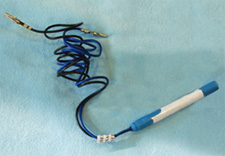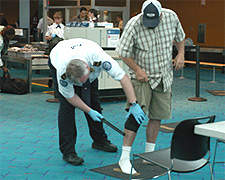TSA's Head-to-Toe Screening Policies
News & Happenings
October 15, 2007
Background
Transportation Security Administration officers screen more than two million passengers every day. It is their primary duty to ensure that each passenger is thoroughly screened to make sure they are not carrying any item that could pose a threat to the aircraft. To do this, TSA has developed sophisticated screening protocols for screening based on several factors, including how passengers are dressed from head to toe.
Improvised Explosive Devices (IEDs) and Their Components

IEDs pose the single greatest threat to aviation. They are designed to do catastrophic damage to the aircraft and could include: explosives, detonators, timers or other parts.
Some of these components are as small as a pen cap and can be extremely difficult to detect through traditional metal-detector based screening. For this reason, officers may conduct additional inspections of any article of clothing that could be used to hide these items.
Baggy, Loose and Flowing Clothing and Additional Screening
Terrorist have used baggy clothing to hide weapons and explosives in the past, including in 2004 when Chechen rebels posed as pregnant women and smuggled explosives aboard two Russian jetliners, killing 90 people.
While passengers can wear any type of clothing they desire, baggy, loose fitting, bulky clothing and head coverings that are non form-fitting present a particular challenge for officers in their mission to ensure IEDs are not smuggled on board. Passengers could be subjected to additional screening to further evaluate any item that could hide explosives or their components.
TSA Screening

Professionally-trained officers receive daily briefings on the latest threats to aviation and the most effective methods to detect these threats. While TSA is working to develop technology to detect non-metallic threat objects, currently the most effective method of detection is asking passengers to remove bulky items like jackets, sweaters, non form-fitting headwear and shoes for the screening process.
If the passenger is uncomfortable removing these items at the security checkpoint, they may be subject to additional screening and will be given the option of this screening taking place in a private location. The objective of this screening is to ensure that no threat items are being hidden on the person. These additional searches may take many forms, including pat-downs, use of explosive trace portals or explosive trace detection.
Your Rights as a Passenger

Travelers can wear any type of clothing or head covering to the security checkpoint. If the officer cannot reasonably determine that the clothing or head covering is free of a threat item, individuals may be referred for additional screening. Officers must use their professional discretion to determine if a particular item of clothing could hide a threat object.
When additional screening is necessary, a private screening location will be made available. It is TSA's policy that passengers should be screened by an officer of the same gender in a professional, respectful manner.
Passengers that believe their civil rights or liberties have been infringed upon during the screening process are encouraged to contact TSA's Office of Civil Rights and Liberties at: http://www.tsa.gov/research/civilrights/civilrights_travelers.shtm
What is TSA Doing to Ensure Passengers' Rights While Providing Security?
TSA has engaged in dialogue with several diverse communities and is committed to continuing to provide a high level of security while being respectful of individuals' rights and liberties. To that end, TSA will:
- Clarify private screening options with officers and instruct them to offer private screening proactively if the passenger is uncomfortable removing the item at the security checkpoint.
- Amend Standard Operating Procedures to provide officers several options when providing additional screening of bulky clothing items, including explosive trace portals, limited pat-downs and explosive trace detectors.
- Include TSA security officers and other federal employees that may have direct knowledge of diverse cultures to provide insight and assistance with developing additional training aids.
- Create and distribute an illustrative training video showing how to provide a high level of security screening in a respectful manner.
TSA will continue to actively engage in dialogue on these matters and will work with community leaders to address specific issues with the security screening process.


